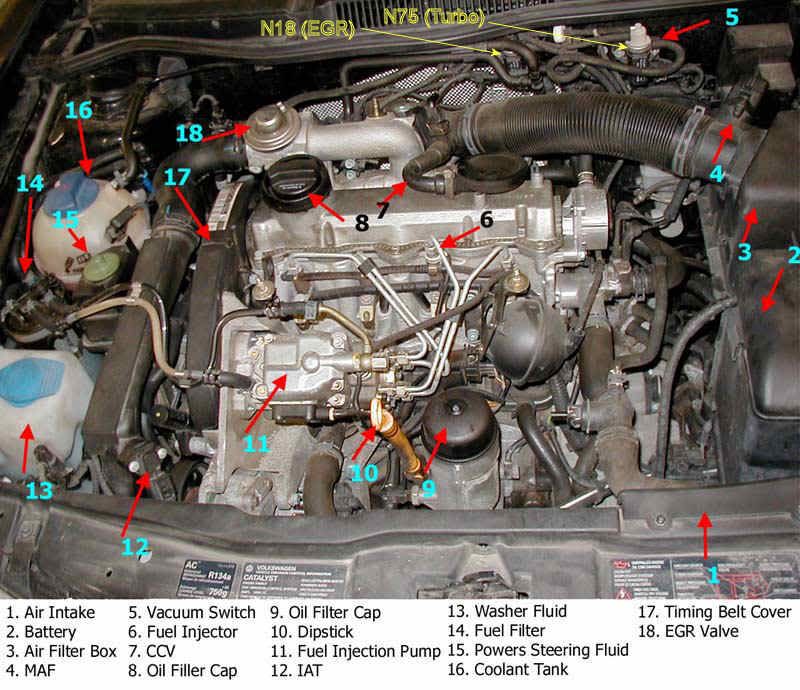Hey guys, hopefully this will be of much more use than my lame excuse for describing problems, as my problem describing can be very poor at best! 
Anyway, from what I know of and from the amount of vacuum diagrams I've check, a pipe that is not currently connected should be connected from the looks of all the similar engine code diagrams to my N75 Turbo Solonoid.
Though that has a black plug like connector on the atmosphere connection which again should be connected from the looks of it to the Air Filter but T-lined to the same connection from the N18 EGR Solonoid.
On to my pictures then reference pictures used.
Here's my own personal hand drawn image of how my pipes are currently hooked up.

The black plug like stopper (not a clue what this is )
)

Connection to the Air Filter showing pipe from N18 Solonoid with the disconnected pipe coming from the T-line which by rights should be connected to the back (Atmosphere) of the N75 Solonoid though as you can see there is the black plug like stopper...

Here is a link to all of the pictures taken of my pipe work, there is more pictures there than there is that I've put up here, 11 pictures in total. Israar's Vacuum Pipe Connections 14.4.15
There reference pictures I have been going over are one that Muttley drew up himself

One that I found scouring the internet that looks VERY similar if not identical to the way mine is supposed to be

As I've mentioned, though I'll restate this I have got my EGR blanked off with plates (which a garage did for me and they also changed my turbo too), I'm unsure on whether or not they fitted this black plug when they blanked off my EGR or whether it was there when I originally bought the car. Like a numpty I never took pictures of the car under the bonnet before I bought it for reference...
The black plug like stopper seems pretty tight, though going over my pipes some of them seem soft like they have worn away somewhat over the years (which is bound to happen anyway).
My question is, does anyone know what effect would be happening with this the way it is? What might be happening? What would happen if the black plug was removed from the N75 and the disconnected pipe put back on to the N75 with the EGR valve being blanked off with plates?
Hope this can shed some light and hope you all like my drawing hahaha!
Thanks in advance!
--Lee
Anyway, from what I know of and from the amount of vacuum diagrams I've check, a pipe that is not currently connected should be connected from the looks of all the similar engine code diagrams to my N75 Turbo Solonoid.
Though that has a black plug like connector on the atmosphere connection which again should be connected from the looks of it to the Air Filter but T-lined to the same connection from the N18 EGR Solonoid.
On to my pictures then reference pictures used.
Here's my own personal hand drawn image of how my pipes are currently hooked up.

The black plug like stopper (not a clue what this is

Connection to the Air Filter showing pipe from N18 Solonoid with the disconnected pipe coming from the T-line which by rights should be connected to the back (Atmosphere) of the N75 Solonoid though as you can see there is the black plug like stopper...

Here is a link to all of the pictures taken of my pipe work, there is more pictures there than there is that I've put up here, 11 pictures in total. Israar's Vacuum Pipe Connections 14.4.15
There reference pictures I have been going over are one that Muttley drew up himself

One that I found scouring the internet that looks VERY similar if not identical to the way mine is supposed to be

As I've mentioned, though I'll restate this I have got my EGR blanked off with plates (which a garage did for me and they also changed my turbo too), I'm unsure on whether or not they fitted this black plug when they blanked off my EGR or whether it was there when I originally bought the car. Like a numpty I never took pictures of the car under the bonnet before I bought it for reference...

The black plug like stopper seems pretty tight, though going over my pipes some of them seem soft like they have worn away somewhat over the years (which is bound to happen anyway).
My question is, does anyone know what effect would be happening with this the way it is? What might be happening? What would happen if the black plug was removed from the N75 and the disconnected pipe put back on to the N75 with the EGR valve being blanked off with plates?
Hope this can shed some light and hope you all like my drawing hahaha!

Thanks in advance!
--Lee




